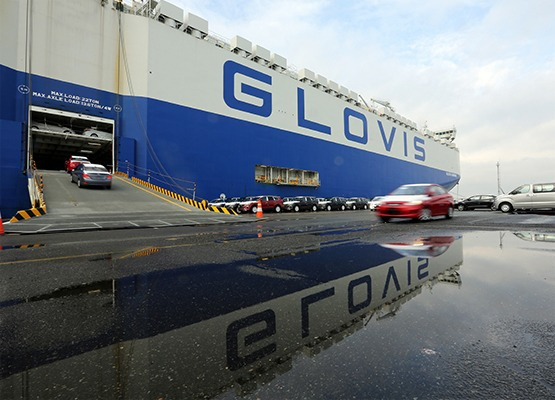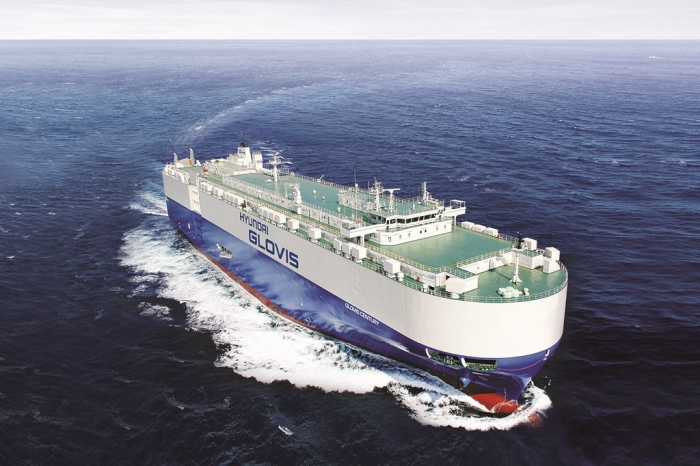Shipping & Shipbuilding
HMM, Hyundai Glovis aim for car shipping sector as rates jump
Hyundai Glovis aims to handle shipments of more cars by other automakers than Hyundai, Kia’s vehicles with fleet expansion
By Feb 20, 2024 (Gmt+09:00)
4
Min read
Most Read
LG Chem to sell water filter business to Glenwood PE for $692 million


Kyobo Life poised to buy Japan’s SBI Group-owned savings bank


KT&G eyes overseas M&A after rejecting activist fund's offer


StockX in merger talks with Naver’s online reseller Kream


Mirae Asset to be named Korea Post’s core real estate fund operator



South Korea’s major ocean carriers HMM Co. and Hyundai Glovis Co. aim to take advantage of the booming car shipping business as vehicle freight rates are expected to rise further after surging by nearly ten times given the shortage of vessels and the increase in Chinese automobile exports.
HMM, the country’s top container line, ordered seven new vessels to restart the car shipping business, which it sold more than 20 years ago. Hyundai Glovis, the world’s third-largest vehicle shipping company, plans to expand its car carrier fleet by more than 25% by 2027.
The rate for a 6,500-CEU pure car and truck carrier (PCTC) skyrocketed to $115,000 per day as of January from an average of $12,625 per day in 2021, according to global shipping research institution Clarksons Research. The rate was $72,167 per day on average last year, nearly triple of $25,583 in 2022.
CEU, which stands for car equivalent unit, is used to measure the capacity of vehicles or car carriers. A CEU is generally based on the dimensions of a 1966 Toyota Corona RT43, which is 4125 mm x 1550 mm x 1400 mm.
VESSEL SHORTAGE
The charter rates have been rising due to the shortage of car carriers amid tighter maritime emission regulations and the increase in Chinese car exports.
The shortage came as 49 car carriers with low efficiency among the total 770 vehicle vessels have been scrapped since 2019. Those scrapped ships were expected to miss the energy efficiency existing ship index (EEXI) and the carbon intensity indicator (CII) introduced by the International Maritime Organization (IMO) last year.
The global car carrier supply is predicted to worsen further as many ships aged about 30 years are scheduled to be scrapped from next year. The shipping industry expects 116 aged vessels to be demolished by 2027.
To ease the vessel shortage, global car carrier operators ordered 188 ships by the end of last year. Five Chinese shipbuilders such as China Merchants Jinling Shipyard Co. won more than 70% of the orders, securing deals to build 132 of those vessels.
The shipping industry doubted if those Chinese shipyards could meet delivery schedules as they have completed only 15 car carriers since 2012.
Lasse Kristoffersen, CEO of Wallenius Wilhelmsen, the world’s top operator of car carriers with 125 vessels, expected vessel deliveries originally scheduled this year to be postponed to after next year, saying in the company’s recent earnings call that shipbuilders usually delay deliveries when they manufacture unfamiliar vessels.
SURGING CHINESE CAR EXPORTS
China’s rising car exports deteriorated the supply shortage. The country became the world’s top automobile exporter, selling 4.9 million vehicles in overseas markets in 2023, up 58% from the previous year.
Wallenius Wilhelmsen said China’s vehicle exports to Europe rose 17.7% in the fourth quarter of 2023 from a year earlier, driven by battery-electric models.
The world’s largest EV-producing country is also trying to export the clean vehicles to other countries, given slowing local sales.
Chinese automakers are expected to increase capacity for 5 million cars, mostly EVs, between 2023 and 2025, while car sales are predicted to grow by 3.7 million during the period, according to industry tracker Bernstein Research.
BYD Co., the world’s No. 1 EV maker, plans to introduce seven car carriers to export its eco-friendly cars to Europe.
RESTART, EXPAND
After more than 20 years, HMM ordered seven new car carriers to resume the business.
The company, formerly Hyundai Merchant Marine, sold its car carrier business for 1.5 trillion won ($1.1 billion) in 2002 to Eukor Car Carriers Inc., a joint venture between Wallenius Wilhelmsen and Hyundai Motor Group, South Korea’s top automaker, to ease its liquidity crisis. Eukor currently operates some 50 vehicle-carrying ships.

Hyundai Glovis, the logistics unit of Hyundai Motor Group, is set to charter those seven new car carriers ordered by HMM, which will be delivered from 2025 in stages.
Hyundai Glovis plans to increase its car carrier fleet to 110 vessels from the current 87 by chartering ships for short and medium terms.
The company, which handles overseas shipments of cars made by the group’s two automaking units Hyundai Motor Co. and Kia Corp., aims to fill more than 50% of those ships with vehicles made by other carmakers to diversify profit sources.
“We plan to sign deals with automakers in the US and Europe to operate the routes of Europe-North America, Europe-Middle East and the east coast of South America-the west coast,” said a Hyundai Glovis official.
Write to Jin-Won Kim at jin1@hankyung.com
Jongwoo Cheon edited this article.
More to Read
-
 AutomobilesSouth Korea's car exports to US hit record high in 2023
AutomobilesSouth Korea's car exports to US hit record high in 2023Feb 16, 2024 (Gmt+09:00)
1 Min read -
 LogisticsHyundai Glovis to raise car shipping rates amid vehicle carrier shortage
LogisticsHyundai Glovis to raise car shipping rates amid vehicle carrier shortageSep 04, 2023 (Gmt+09:00)
2 Min read -
 LogisticsHyundai Glovis to secure additional 12 car transport vessels by 2025
LogisticsHyundai Glovis to secure additional 12 car transport vessels by 2025Aug 09, 2023 (Gmt+09:00)
1 Min read
Comment 0
LOG IN


